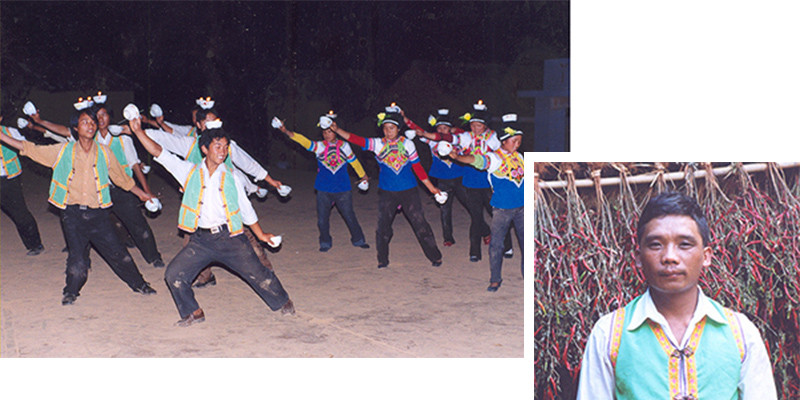Li Bing, male, of the Yi ethnic group, was born in 1969 in [Yakege Village (丫科革村)], [Binglie Township (秉烈乡)], [Wenshan City (文山市)], [Wenshan Zhuang and Miao Autonomous Prefecture (文山壮族苗族自治州)]. He is a renowned performer of the Shen Deng (Sacred Lantern) Dance in the local area. At the age of 11, he became an apprentice of [Li Kaihua (李开华)], a villager from his hometown, learning traditional musical instruments and the techniques of the Shen Deng Dance. Li Bing is not only highly skilled but also actively engaged in the transmission and promotion of the dance. He is a representative inheritor of the Shen Deng Dance, a prefecture-level intangible cultural heritage item.
Introduction to the Shen Deng Dance
The Shen Deng Dance is a ritual dance of the Yi ethnic subgroup known as the [Aza (阿扎)] people in [Yakege Village (丫科革村)], [Binglie Township (秉烈乡)], [Wenshan City (文山市)]. It boasts a long history and unique cultural significance. The dance is performed during festivals and traditional occasions. Dancers balance oil lamps on their heads and execute intricate movements such as backbending, lamp gripping, lamp rolling, forehead balancing, and lamp spinning. At times, dancers cluster together like a torch, while at other times, they scatter like stars. The Shen Deng Dance is not only a spiritual expression of the Yi people but also a vital part of local cultural identity.

 7 Days GolfingTour
7 Days GolfingTour
 8 Days Group Tour
8 Days Group Tour
 8 Days Yunnan Tour
8 Days Yunnan Tour
 7 Days Shangri La Hiking
7 Days Shangri La Hiking
 11 Days Yunnan Tour
11 Days Yunnan Tour
 6 Days Yuanyang Terraces
6 Days Yuanyang Terraces
 11 Days Yunnan Tour
11 Days Yunnan Tour
 8 Days South Yunnan
8 Days South Yunnan
 7 Days Tea Tour
7 Days Tea Tour
 8 Days Muslim Tour
8 Days Muslim Tour
 12 Days Self-Driving
12 Days Self-Driving
 4 Days Haba Climbing
4 Days Haba Climbing
 Tiger Leaping Gorge
Tiger Leaping Gorge
 Stone Forest
Stone Forest
 Yunnan-Tibet
Yunnan-Tibet
 Hani Rice Terraces
Hani Rice Terraces
 Kunming
Kunming
 Lijiang
Lijiang
 Shangri-la
Shangri-la
 Dali
Dali
 XishuangBanna
XishuangBanna
 Honghe
Honghe
 Kunming
Kunming
 Lijiang
Lijiang
 Shangri-la
Shangri-la
 Yuanyang Rice Terraces
Yuanyang Rice Terraces
 Nujiang
Nujiang
 XishuangBanna
XishuangBanna
 Spring City Golf
Spring City Golf
 Snow Mountain Golf
Snow Mountain Golf
 Stone Mountain Golf
Stone Mountain Golf













 What Our Customers Say?
What Our Customers Say? alt="Market Days in Menglian and Townships, Puer"
/>
alt="Market Days in Menglian and Townships, Puer"
/>

